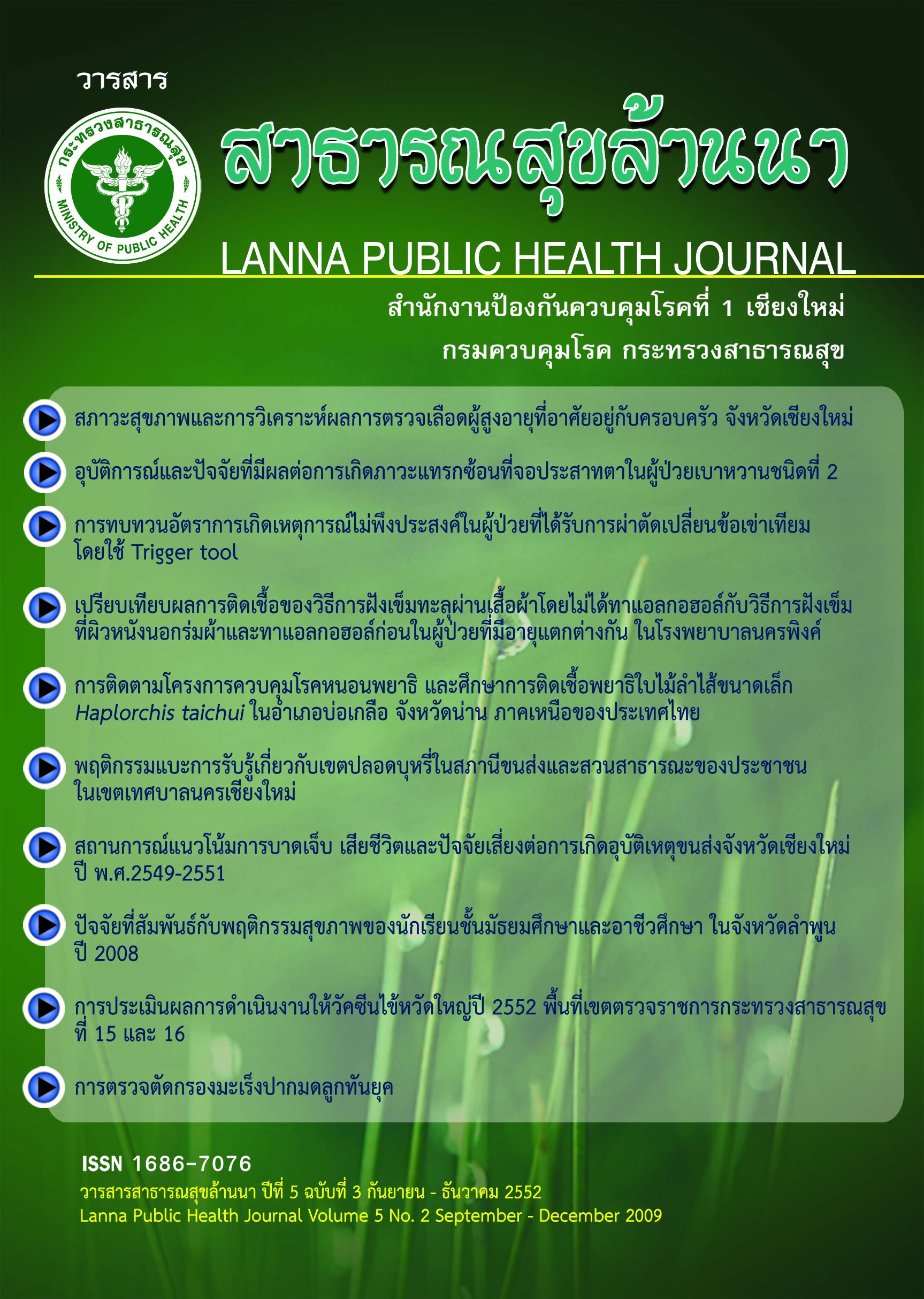การตรวจคัดกรองมะเร็งปากมดลูกทันยุค
บทคัดย่อ
อุบัติการณ์ของมะเร็งปากมดลูกทั่วโลกสูงเกือบ 5000,000 รายต่อปี และมีผู้ป่วยเสียชิวตมากกว่า 270,000 รายต่อปี1 หรือทุกๆ 2 นาที จะมีสตรีเสียชีวิตจากมะเร็ง หลายปีที่ผ่านมาประเทศที่พัฒนาแล้วอุบัติการณ์ของมะเร็งปากมดลูกลดลงอย่างมาก เป็นผลจากการตรวจคัดกรองมะเร็งปากมดลูกเพื่อหาความผิดปกติของปากมดลูกระยะก่อนมะเร็ง และรักษาแต่เนิ่นๆ ทำให้ลดการเกิดมะเร็งปากมดลูกได้มาก3 มะเร็งปากมดลูกเป็นมะเร็งที่พบมากที่สุดของสตรีไทย มีอุบัติการณ์ปรบมาตรฐานตามอายุ (age standardized rate) 19.8 ต่อแสนประชากร 100,000 คนต่อปี และ the international Agency for Research on Cancer (LARC) รายงานว่าประเทศไทยพบมะเร็งปากมดลูกใหม่ปี่ละ 6,243 ราย และเสียชีวิต 2,620 ราย1 หรือทุกวันมีสตรีไทยเสียชิวิตด้วยโรคมะเร็งปากมดลูก 7 คน
เอกสารอ้างอิง
Nieminen P, Kallio M, Hakama M. the effectof mass screening on ncidence and mortalty of squamous and adenocarcinoma of cervx uteri. Obstet Gynecol 1995; 85”1017-1021.
Warner EE, Mulshine JL. Lung cancer screening with spiral CT: toward a working strategy. Oncology (Williston Park) 2004; 18:56Y75.
Fahey MT, lrwing L & Macaskill P. Meta-analysis of Pap test accuracy. Am J Epidemiol 1995; 141:680-689.
McCrory DC, Matchar DB, Bastian L et al. Evaluation of Cervical Cytology. Evidence Report/Technology Assessment no. 5 (Prepared by Duke University under Contract no.29-97-0014). AHCPR Publication no. 99-E010. Rockville, MD: Agency for Health Care Policy and Research: 1999.
Nada K, McCrory DC, Myers ER et al. Accuracy of the Papanicolaou test in screening for and follow-up of cervical cytologic abnormalities: a systematic review. Ann Intern Med 2000; 132:810-819
Cronje HS, Cooreman BF, Beyer E et al. Screening for cervical neoplasia in a develpong country utilizing cytology, cervicography and the acetic acid test. Int J Gynecol Obstet 2001; 72:151-157.
Cronje HS. Parham GP, Cooreman BF et al. A comparison of four screenin g mehods for cervical neoplasia sin a developing country. Am J obstet Gynbecol 2003; 188:395-400.
Bernstein SJ, Sanchez-Ramos L, Ndubisi B. Liquid-basedd cervical cytologic smear study and comventional Papanicoaou smears: a meta-analysis of prospective studies comparing cytologic sample diagnosis, sample adequacy. Am J Obseer Gynecol 2001;185;308-17.
Guidos BJ. Selvaggi SM. Use of the ThinPrep test in clinical practice. Diagn Cytopathol 1999: 20:70-3.
Scottish Cervical Screeing Programme. Steering group report on the feasibility of introducing liquid-base cytology (monograph online) Edinburgh: Scottish cervical screening programme} , 2002. Available online at http://www.omni.ac.uk/browse/mesh/detail/C0010818L0010818.html.
National institute for Clinical Exccellence, Final. Appraisal consultation document: guidance on the use of liquid-based cytology for cervical screening (review of existing guidance Number5) (monograph online). London: NICE, 2003” Available online at http://www.nice.org.uk/Docref.asp?d=82877.
Agency for Health care Policy and Research Evaluation of cervical cytology: evidence report/technology assessment (no.5) Rockville, MD: AHCPR, January 1999” online monograph: http://www.ahcper.gov/clinic/epsums/cervsumm.htm.
Molign A, Kleter B, Quiint W, van Doom L, Molecular diagnosis of human pupillomavirua (HPV) infetions. J Clin Virology 2005;32S:S43-S51.
Lorincz AT, Hybrid Capture method for detection of human papillomavirus DNA in clinical specimens: a tool for clinical management of equivocal Pap smcars and for population screening. J Obstect Gynaecol Res 1996;22:629-36.
Bozzetti M, Nonnenmacher B, Mielzinska I, Vill L, Lorincz A, Breitent=bach V, et al . Comparison beteween Hybrid Capture II and polymerase chain reaction results amoing women ar low-risk ifr cervical cancer . Ann Epidemilo 2000; 10:466.
Walboomers JM, Jacobs MV, Manos MM, Bosch Fx, Kummer JA, Shah KV, et al . Human papillomavirus is a necessary cause of invasive cervical cancer worldwide. J Pathol 199;189:12-9
Bosch FX, Lorincz A, Munoz N, Meijer CJ, Shah KV. The causal relation between human popillomanvirus and cervical cancer. J Clin Pathol 2002;55:244-65.
Clavel C, Masue M, Bory JP, Putaud I, Mageonjcan C, Lorenzto F, et al.. Human Papillomavirus in primary screening for the detectionof high-grade cervical lesiions: a stud of 7932 women. Br J Cancer 2001:89:1616-23.
Petry KU, Menton S, Menton M, van Loenen-Frosch F, de Carvalho Gomes H, Holz B, et al . inlusion of HPV testing in routine cervical cancer screening for women above 29 years in Germany: results for 8466 patients Br J Cancer 2003; 88:1570-7.
Kulasingam SL, Hugher JP, Kinat NB, Mao C, Weiss NS, Kuyper JM, et al. Evaluation of HPV guidelines and issues in cancer screening CA Cacer J Clin 2009:59:27-41.
Meijer Clm<, Rozendaal L., vander Linden JC. Human papillomavirus testing for primary cervical abnormalities: comparison of sensitivity, specificity, and frequency of referral, JAMA 2002;288:1749-55.
Cuzick J, Szarewski A, Cubie H, Hulman G, Kitchener H, Luresley D, et al. Management of women who rest positive for hig-risk types of human papillomarirus: the HART study. Lacet 2003;362:187-6.
Robert A. Smith, Vilman cokkinides and Otis W. Brawley. Cancer screening in the United states, 2009; A review of current American Cancer Society
Moberg M, Gustavsson I, Gyllenten U, Type-specific association of human papillomavirus load with risk of developing cervical carcinoma I situ. Int J Cancer 2004;112:854-9.
Gravitt PE, Kovacic MB, Herrero R. Schifiman M, Bratti C, Hildesheim A. et al. High load for most high ris human papillomavirus genotypes is associated with prevalent cervical cancer precursors but only HPV16 load predicts the development of incident disease. Int J Cancer 2007: 121(12): 2787-93.
Pett M, Coleman N. integration of high-risk human papillomavirus: a key event in cervical carcinogenesis? J Pathol 2007; 212(4): 356-67.
Klaes R, Woerner Sm. Ridder R, Wentzensen N, Durest M, Sxhneider A, et al. Detection of high-risk cervical intraepithelial neoplastic and cervical cancer Res 1999;59(24);6132-6.
Luft F, Klaes R, Nees M, Durest M, Heilamann V, Melsheimer P, et atl Detectionof
Peitsaro P, Johansson B, Syrjanen S. Integrated human papillomavirus type16 is frequently found in cervical cancer procursors as demonstrated by a novel quatitative real-time PCR technique, J Clin Microbill 2002; 40(3): 886-91.
integrated papillomavirus sequences by ligation-medicated PCR (DIPSPCR) and molecular characterization in cervical cancer precursors as demonstrated by a novel quantitative real-time PCR technique. J Clin Microbiol 2002;40(3):886-91.
Klaes R Friedrich T, Spitkovsky D, Ridder R, Rudy W, Petry U, et al.. Overexpression of P16(INK4A) as a specific marker for dysplastic and neoplastic epithelial cells of the cervix uteri. Int J Cancer 2001;92(2):276-84.
Heselmeyer K, Macville M, Schrock E, Blegen H, Hellstrom AC, Shah K, et al.l Advanced-stage cervical carcinomas are defined by a recurrent pattern of chromosomal aberrations revealing high genetic instability and a consisten gain of chromosome arm 3q. Genes Chromosomes Cancer 1997;19(4): 233-40.








